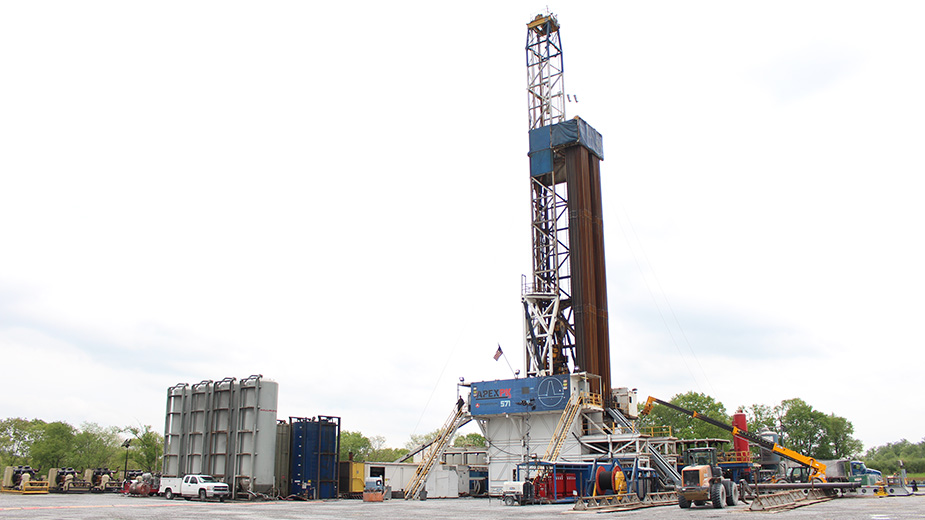Royalties Collapse in Utica as Oil Prices Fall
LISBON, Ohio – Robert Crosser was never under the illusion that he’d become a millionaire because of the residuals from the gas well that Chesapeake Energy Corp. drilled on his Columbiana County farm four years ago.
When Chesapeake placed the well into production last year, the results looked promising. All indications pointed to hefty royalty payments flowing in for years to come. Maybe, just maybe, Crosser thought, earning big money over the life of the well wasn’t so far-fetched after all.
“We were getting over $100 an acre [per month],” says Crosser. “We have just a little over 83 acres in this unit.”
Beginning six months ago, those royalty checks began to shrink as the price of oil and natural gas liquids plummeted, Crosser says. He now estimates his royalty payments are based on $20 to $25 an acre, or an 80% drop below what they were a year ago.
“You can’t get rich on what they’re paying us right now,” Crosser says. “There’s no J.R. Ewing operation here,” he says and laughs, referring to the character of a smarmy oil magnate played by Larry Hagman in the 1980s evening soap “Dallas.”
Crosser is among hundreds of residents across eastern Ohio’s Utica shale whose royalty payments from producing wells are deeply affected by the collapse of commodity prices. Crosser leased his land five years ago as Chesapeake and other energy companies swarmed across this part of state in search of rich deposits of oil, natural gas and natural gas liquids deep in the Utica shale. Chesapeake drilled the Crosser well four years ago.
The lease he signed called for an upfront bonus of $1,500 per acre and 15% royalties on gross production.
The Business Journal first interviewed Crosser a year ago when the first royalty checks started to trickle in. His well, the Crosser 5H, produced a healthy amount of natural gas during the third quarter of 2014 – yielding 301.4 million cubic feet of gas over three months.
The latest reports from the Ohio Department of Natural Resources, however, show production at the Crosser well has gradually decreased, and as of the first quarter of 2015 was producing about half the output recorded during the third quarter of 2014. The Crosser well produced 159.8 million cubic feet during the quarter ended March 31.
Such decreases are typical for wells in the Utica shale because of the normal rate of decline that occurs after they’ve been in production several months, explains Jeffery Dick, chairman of the Department of Geology at Youngstown State University.
“You could see a 60% decline alone in the first year if they’re not controlling production,” Dick says. Moreover, Chesapeake recently announced that it voluntarily curtailed 100 million cubic feet of gas per day throughout the Utica in July, and as of early August was restricting natural gas production by 275 million cubic feet per day.
As for Crosser and other residents of Center Township, there’s little indication that energy companies will resume drilling anytime soon.
“We don’t know when it’s going to rebound around here,” Crosser notes. His well is pumping predominantly dry and wet natural gas and little oil, and Crosser says he’s received no indication that the company would drill another well at the site. “I’ve heard this may continue into 2018,” he says, before any more wells are drilled in this area.
While production and commodity prices have dwindled, Crosser says that Chesapeake claims it made an error and overpaid him for his initial royalties. As such, the company has deducted payments directly from his royalty checks to make up the difference.
“Two months ago, we got nothing,” Crosser relates. “They deducted whatever their mistake was and they deducted this month’s check to where it’s down to very little.”
Still, there are signs that big energy companies such as Chesapeake haven’t abandoned the Utica completely.
Crosser points to those landowners who signed leases five years ago but did not see their land drilled. Many of those leases are set to expire sometime in September, and energy companies such as Chesapeake have already opted to renew some agreements to preserve their stake in Columbiana County. “They’re re-leasing that acreage to keep it in their pocket so they can come back later and drill under them,” Crosser says.
It’s likely that at least some, but not all, of those leases signed five years ago would be renewed, observes Alan Wenger, an attorney at Harrington Hoppe & Mitchell, Youngstown, who heads his law firm’s oil and gas division.
“They’re renewing, but on a selective basis,” Wenger says. That’s because energy companies today have much more geological and well production data in the Utica than they did five years ago. “They can look at the rock strata using newer technology.”
Which is good for the landowners, because companies such as Chesapeake would once again pay out bonuses per acre similar to what was first negotiated five years ago.
“I think there’ll be a fair amount of renewals,” Wenger says.
Permitting activity has dried up throughout the Utica shale as energy companies continue to rein in drilling operations in the face of severely low oil and gas prices. The central and southern tier of the Utica – namely Carroll, Belmont, Monroe and Noble counties – command the most attention from energy companies because well production in this region is much stronger than most of the wells in and north of Columbiana County.
Keith Burgett, a veterinarian who lives just outside of Carrollton, says his family’s farm was among the first to be drilled by Chesapeake in Carroll County. Production at that first well today is much lower than it was when it was placed into production about four years ago, he says. However, oil production appears to be on the increase in this section of Carroll County, he says.
Despite declining royalties, oil and gas development across Carroll County remains very robust in terms of infrastructure work, Burgett notes. “There are a lot of trucks still here,” he says. “There’s new building going on, two new hotels. So that’s the positive thing about it. It’s really come to life.”
The rig count in the Utica – that is, the number of rigs operating in the shale play at any given time – has plunged this year from 53 in January to 25 as of Aug. 15, according to ODNR. Permit activity has also dried up, and some landowners believe Chesapeake is choking off production at some of its wells.
“They’ve taken the motors off some of these wells here,” observes Doyle Hawk, whose land near Augusta in northern Carroll County is tied into five Chesapeake wells. “They’ve shut some down for a while, or cut production way back,” he says.
Hawk says his royalty payments have nosedived since January. “They dropped one month by 25%, then another month by 25%,” he reports. “Then, it leveled off for awhile, and then dropped again.”
Altogether, Hawk estimates, his royalty checks have fallen by $12,000 per month since the collapse began. “They’ve dropped 80% from when the first well was in production,” he says. “We were getting about $100 an acre. Now, it’s about $20.”
Chesapeake, Hawk says, drilled several new wells in the area but has yet to hydraulically fracture them. In the current market, when that would occur is anyone’s guess.
“Prices are bad, and it’s hurting,” Hawk reflects. “The good times are gone for awhile.”
Pictured: Robert Crosser.
Copyright 2024 The Business Journal, Youngstown, Ohio.



